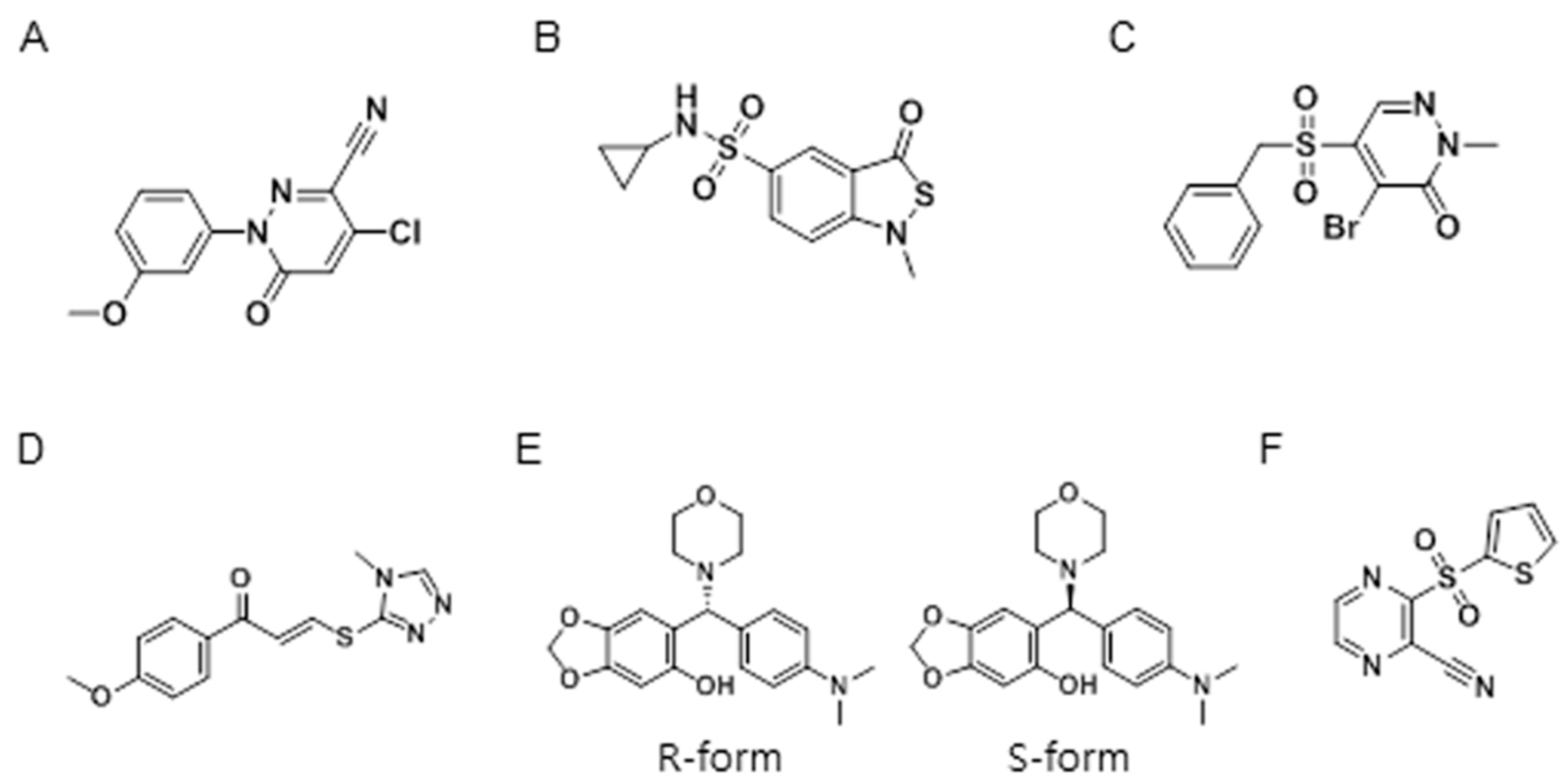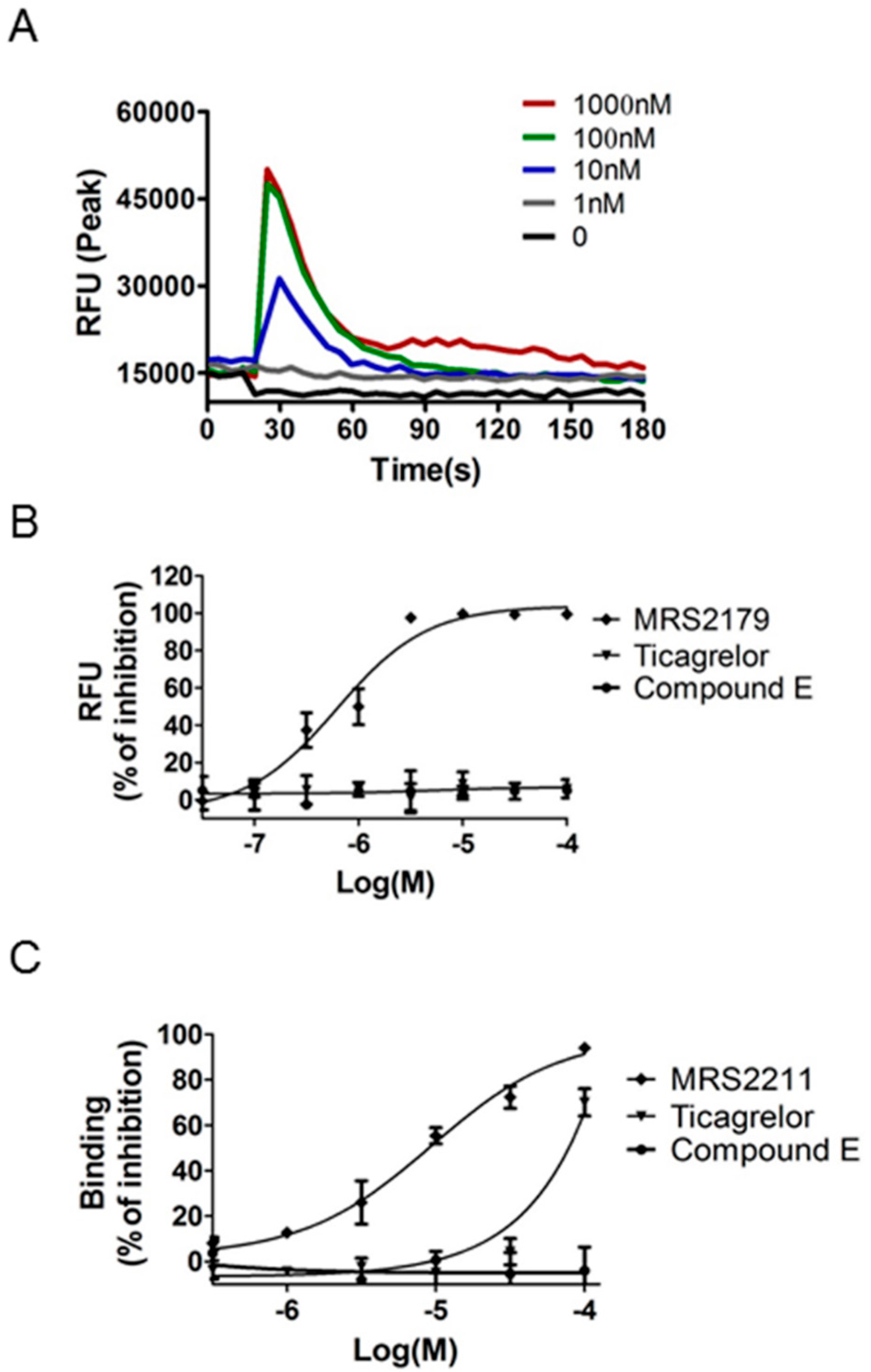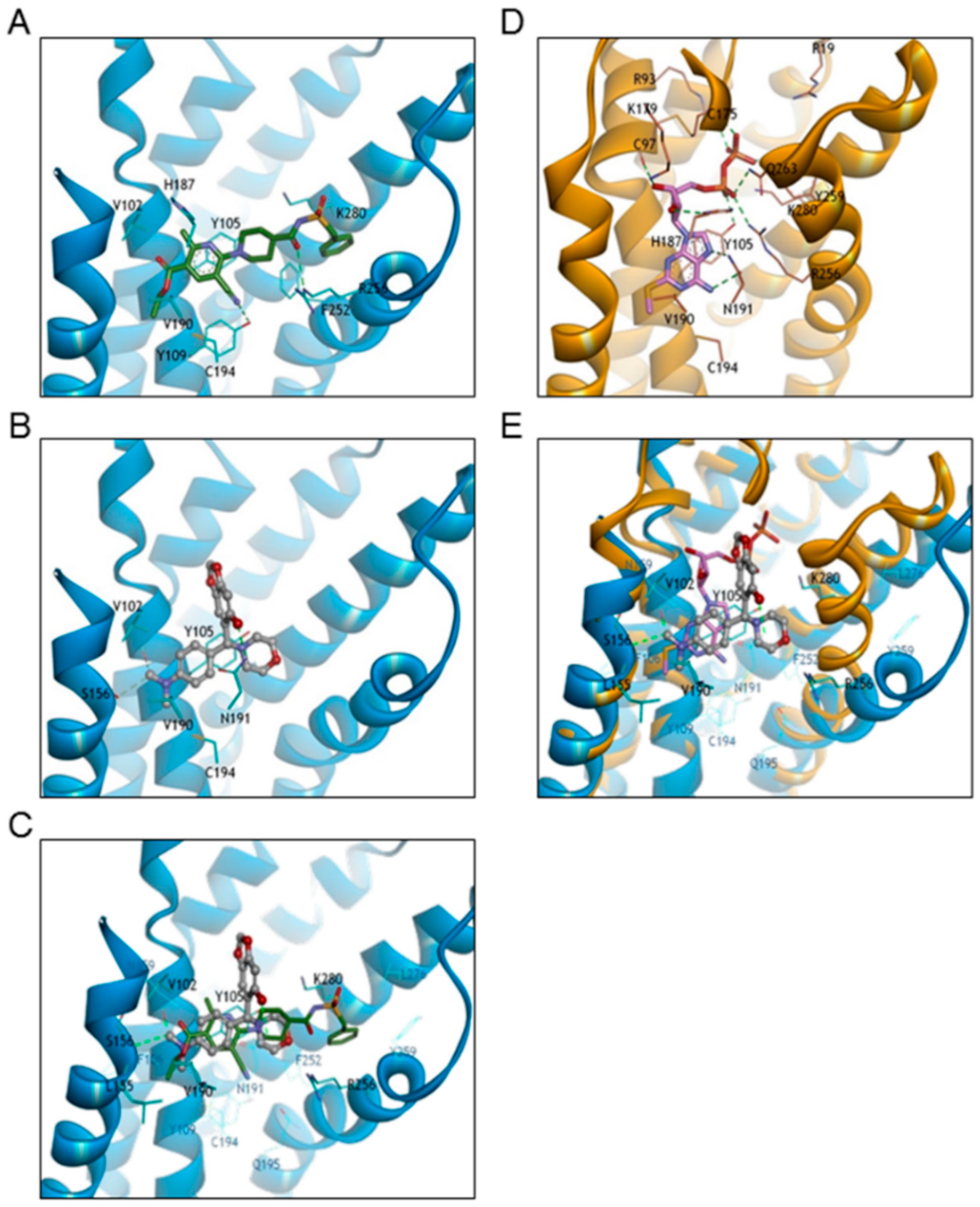Identification of a New Morpholine Scaffold as a P2Y12 Receptor Antagonist
Abstract
:1. Introduction
2. Results
2.1. High-Throughput Screening of Anti-Platelet Compounds
2.2. Anti-Platelet Activities of Selected Compounds
2.3. Binding Affinities of Identified Compounds for the Rhp2y12 Receptor
2.4. Comparison of the Pharmacological Characteristics of Compound E and Ticagrelor
2.5. Selectivity over P2Y1 and P2Y13 Receptors
2.6. Docking Study of Compound E to Human P2Y12 Receptor
3. Materials and Methods
3.1. Chemical Compounds
3.2. Platelet Preparation for Aggregation Studies
3.3. Light Transmission Aggregometry
3.4. Cell Culture
3.5. Human P2Y12 Receptor and P2Y13 Receptor-Binding Assay with [3H]2-Methylthioadp and [3H]ADP
3.6. Ca2+ Mobilization Assay
3.7. Molecular Modeling
3.8. Statistical Analysis
4. Discussion
Acknowledgments
Author Contributions
Conflicts of Interest
References
- Ferreiro, J.L.; Angiolillo, D.J. New directions in antiplatelet therapy. Circ. Cardiovasc. Interv. 2012, 5, 433–445. [Google Scholar] [CrossRef] [PubMed]
- Bonaca, M.P.; Bhatt, D.L.; Cohen, M.; Steg, P.G.; Storey, R.F.; Jensen, E.C.; Magnani, G.; Bansilal, S.; Fish, M.P.; Im, K.; et al. Investigators, Long-term use of ticagrelor in patients with prior myocardial infarction. N. Engl. J. Med. 2015, 372, 1791–1800. [Google Scholar] [CrossRef] [PubMed]
- Shaver, S.R. P2Y receptors: Biological advances and therapeutic opportunities. Curr. Opin. Drug Discov. Dev. 2001, 4, 665–670. [Google Scholar]
- Cattaneo, M. New P2Y(12) inhibitors. Circulation 2010, 121, 171–179. [Google Scholar] [CrossRef] [PubMed]
- Committee, C.S. A randomised, blinded, trial of clopidogrel versus aspirin in patients at risk of ischaemic events (CAPRIE). CAPRIE Steering Committee. Lancet 1996, 348, 1329–1339. [Google Scholar]
- Kam, P.C.; Nethery, C.M. The thienopyridine derivatives (platelet adenosine diphosphate receptor antagonists), pharmacology and clinical developments. Anaesthesia 2003, 58, 28–35. [Google Scholar] [CrossRef] [PubMed]
- Wallentin, L.; Becker, R.C.; Budaj, A.; Cannon, C.P.; Emanuelsson, H.; Held, C.; Horrow, J.; Husted, S.; James, S.; Katus, H.; et al. Ticagrelor versus clopidogrel in patients with acute coronary syndromes. N. Engl. J. Med. 2009, 361, 1045–1057. [Google Scholar] [CrossRef] [PubMed]
- Serra, R.; de Franciscis, S. The need to identify new P2Y(1)(2) receptor inhibitors in the management and prevention of arterial thrombosis. Thromb Res. 2014, 134, 533–534. [Google Scholar] [CrossRef] [PubMed]
- Ferri, N.; Corsini, A.; Bellosta, S. Pharmacology of the new P2Y12 receptor inhibitors: Insights on pharmacokinetic and pharmacodynamic properties. Drugs 2013, 73, 1681–1709. [Google Scholar] [CrossRef] [PubMed]
- Bednar, B.; Condra, C.; Gould, R.J.; Connolly, T.M. Platelet aggregation monitored in a 96-well microplate reader is useful for evaluation of platelet agonists and antagonists. Thromb. Res. 1995, 77, 453–463. [Google Scholar] [CrossRef]
- Chan, M.V.; Armstrong, P.C.; Papalia, F.; Kirkby, N.S.; Warner, T.D. Optical multichannel (optimul) platelet aggregometry in 96-well plates as an additional method of platelet reactivity testing. Platelets 2011, 22, 485–494. [Google Scholar] [CrossRef] [PubMed]
- Van Giezen, J.J.; Nilsson, L.; Berntsson, P.; Wissing, B.M.; Giordanetto, F.; TomLinson, W.; Greasley, P.J. Ticagrelor binds to human P2Y(12) independently from ADP but antagonizes ADP-induced receptor signaling and platelet aggregation. J. Thromb. Haemost. 2009, 7, 1556–1565. [Google Scholar] [CrossRef] [PubMed]
- Van Giezen, J.J.; Berntsson, P.; Zachrisson, H.; Bjorkman, J.A. Comparison of ticagrelor and thienopyridine P2Y(12) binding characteristics and antithrombotic and bleeding effects in rat and dog models of thrombosis/hemostasis. Thromb. Res. 2009, 124, 565–571. [Google Scholar] [CrossRef] [PubMed]
- Zhang, J.; Zhang, K.; Gao, Z.G.; Paoletta, S.; Zhang, D.; Han, G.W.; Li, T.; Ma, L.; Zhang, W.; Muller, C.E.; et al. Agonist-bound structure of the human P2Y12 receptor. Nature 2014, 509, 119–122. [Google Scholar] [CrossRef] [PubMed]
- Zhang, K.; Zhang, J.; Gao, Z.G.; Zhang, D.; Zhu, L.; Han, G.W.; Moss, S.M.; Paoletta, S.; Kiselev, E.; Lu, W.; et al. Structure of the human P2Y12 receptor in complex with an antithrombotic drug. Nature 2014, 509, 115–118. [Google Scholar] [CrossRef] [PubMed]
- Arkin, M.R.; Connor, P.R.; Emkey, R.; Garbison, K.E.; Heinz, B.A.; Wiernicki, T.R.; Johnston, P.A.; Kandasamy, R.A.; Rankl, N.B.; Sittampalam, S. FLIPR Assays for GPCR and Ion Channel Targets. In Assay Guidance Manual; Sittampalam, G.S., Coussens, N.P., Nelson, H., Arkin, M., Auld, D., Austin, C., Bejcek, B., Glicksman, M., Inglese, J., Iversen, P.W., et al., Eds.; National Center for Advancing Translational Sciences: Bethesda, MD, USA, 2004. [Google Scholar]
- Sample Availability: Samples of the compounds are not available from the authors.






| Ligand | 20 μM ADP (IC50, μM) | Compounds | 20 μM ADP (IC50, μM) |
|---|---|---|---|
| ATP | 2.14 ± 0.51 | A | 8.04 ± 0.51 |
| MRS2179 | 1.1 ± 0.01 | B | 9.49 ± 1.15 |
| 2-MeSAMP | 1.09± 0.16 | C | 4.03 ± 0.95 |
| Ticagrelor | 0.32 ± 0.02 | D | 6.08 ± 0.11 |
| E | 6.21 ± 0.71 | ||
| F | 9.35 ± 2.19 |
| Compounds | IC50 vs. [3H]-2-MeSADP (μM) | IC50 vs. [3H]ADP (μM) |
|---|---|---|
| A | >30 | >30 |
| B | >30 | >30 |
| C | >30 | >30 |
| D | >30 | >30 |
| E | 15.51 ± 2.24 | 8.33 ± 1.69 |
| F | >30 | >30 |
| Ligand | IC50 vs. [3H]-2-MeSADP (μM) | IC50 vs. [3H]ADP (μM) |
|---|---|---|
| 2-MeSADP | 0.12 ± 0.02 | 17.22 ± 4.62 |
| ADP | 24.78 ± 2.09 | 0.19 ± 0.10 |
| Ticagrelor | 0.04 ± 0.02 | 8.40 ± 3.05 |
| Compound E | 15.51 ± 2.24 | 8.33 ± 1.69 |
© 2016 by the authors. Licensee MDPI, Basel, Switzerland. This article is an open access article distributed under the terms and conditions of the Creative Commons Attribution (CC-BY) license ( http://creativecommons.org/licenses/by/4.0/).
Share and Cite
Ahn, Y.H.; Lee, J.-Y.; Park, H.D.; Kim, T.H.; Park, M.C.; Choi, G.; Kim, S. Identification of a New Morpholine Scaffold as a P2Y12 Receptor Antagonist. Molecules 2016, 21, 1114. https://doi.org/10.3390/molecules21091114
Ahn YH, Lee J-Y, Park HD, Kim TH, Park MC, Choi G, Kim S. Identification of a New Morpholine Scaffold as a P2Y12 Receptor Antagonist. Molecules. 2016; 21(9):1114. https://doi.org/10.3390/molecules21091114
Chicago/Turabian StyleAhn, Young Ha, Joo-Youn Lee, Hee Dong Park, Tae Hun Kim, Min Chul Park, Gildon Choi, and Sunghoon Kim. 2016. "Identification of a New Morpholine Scaffold as a P2Y12 Receptor Antagonist" Molecules 21, no. 9: 1114. https://doi.org/10.3390/molecules21091114






